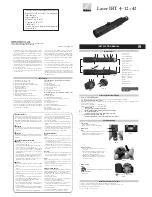
- 15 -
Telescope mounts
The technical aids which ensure that the optical tube of a telescope can be moved in
different directions are summarised under the term "telescope mount" or "mount". These
telescopic mountings can be divided into two basic designs:
Azimuth mounts allow the telescope tube to move vertically and horizontally. The MCX
has an azimuthal mount (fig. 27). In this azimuthal configuration, the telescope is ideally
suited for all terrestrial applications and for occasional astronomical observations. For
this purpose, you may place the telescope on a fixed table top without further ado. Of
course, the field tripod supplied as standard is recommended as a safe, height-adjustable,
azimuthal observation foundation. To adjust and manually track various objects - whether
terrestrial or astronomical - with the telescope mounted in the azimuthal configuration,
the observer simply presses the arrow keys of the handheld computer (5, fig. 25; page
34).
Automatic tracking in both axes is only possible after successful 1-star, 2-star or 3-star
alignment (see pages 24 and 25).
Equatorial (parallactic) mounts are exceptionally advantageous when a telescope is to
be used for extensive astronomical applications, as the celestial objects move neither
horizontally nor vertically, but follow a combination of these two directions of motion.
If you use one of the mechanical telescopic axles (see Fig. 28) tilts until it points to the
celestial pole (i.e. by aligning this telescope axis with the polar star), astronomical objects
can be tracked by moving only this axis of the telescope. With the azimuthal mount, both
axes must be moved simultaneously instead. An equatorial mount in which one of its
axes (the so-called polar axis) points to the celestial pole is called "aligned with the pole".
You can align the MCX to the terminal. Use the supplied field tripod with pole height
cradle.
Once you have aligned the MCX with the pole, follow the instructions on page 19 (Aligning
the MCX with the Sky Pole). This enables you to track celestial objects particularly evenly.
In this configuration, the observer no longer has to press the arrow keys of the handheld
computer to track the celestial objects. Independent of the automatic tracking, the arrow
keys of the Autostar are very helpful in this configuration when it comes to centering
objects in the center of the telescope's field of view, or if you want to wander over the
lunar surface with the telescope, for example, or wander through a larger star field.
The handheld:
The handheld computer allows you to operate your MCX with either the
azimuthal or equatorial mount. The azimuthal mount is superior to the equatorial mount in
terms of stiffness and stability, but has the disadvantage that the tracking of astronomical
objects is less accurate. The handheld computer of the MCX compensates for this as
far as possible with computer-controlled tracking - this combines the advantages of
both mounting types, but avoids the disadvantages! In astrophotography, however, the
equatorial mount should be preferred due to the rotation of the image field. In addition, the
handheld computer has the option of automatically approaching astronomical objects.
Terrestrial Observations
The high-resolution MCX is both an astronomical and a terrestrial telescope. If you use
the telescope as shown in Fig. 27, then you can use it for an extremely comprehensive
range of observations. Never forget, however, that the terrestrial images may be upright,
but are displayed in reverse as soon as you look through the eyepiece. Normally this
image orientation is not too annoying, unless you want to read a remote license plate or
similar.
The observation of terrestrial objects requires a viewing direction along the earth's
surface through heat streaks. These heat streaks often cause serious losses in image
quality. Low magnification eyepieces, such as the SP 26mm eyepiece, enhance the effect
of these streaks less than eyepieces with higher magnifications. For this reason, weaker
magnifying eyepieces provide a smoother image with higher image quality. If the image
appears blurry or poorly defined, downgrade to a lower magnification where the heat
streaks will not have such a devastating effect on the image quality. Observation during
the early morning hours, before a heat accumulation has formed on the ground, usually
offers better visibility conditions than during the late afternoon hours.
Basic knowledge
V
Fig. 27
Fig. 28
The azimuthal mount moves the telescope
vertically and horizontally.
(1 = Azimuth; 2 = Height (Elevation))
The equatorial mount is aligned with the
celestial pole. (1 = right ascension; 2 =
declination; 3 = polar star)
Summary of Contents for MCX Goto Series
Page 30: ...30 Computerised Handset with LED display VII Fig 35...
Page 39: ...39...












































